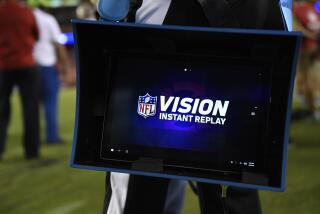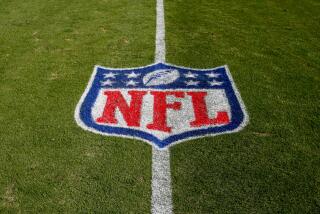Football concussions: The smaller hits matter too
- Share via
If you feed, clothe and care for one of the nation’s 1.1 million high school football players or 3 million younger kids playing tackle football, get ye to a newsstand for this week’s issue of Sports Illustrated, a special edition devoted to the subject of concussions.
Certainly, in the wake of the NFL’s decision to fine and possibly suspend players found to inflict flagrantly dangerous hits, you’ll want to read about the “hits that are changing the game.”
But the piece that should really get your attention is about the “hits no one is noticing.”
SI writer David Epstein reports on the unexpected findings made by researchers at Purdue University, who spent last fall’s football season testing, wiring, watching, filming, analyzing and retesting 23 members of the Jefferson High School Broncos in Lafayette, Ind. Against the backdrop of research linking repeated concussions to later-life problems of memory, cognition and movement, the Purdue researchers gleaned some troubling possibilities: that football players may not have to wait for later in life to detect cognitive problems, and that those problems may follow blows to the head that happen day-in and day-out in youth football and are not now recognized as “flagrantly dangerous.”
Which is not to say the speed and power of high school collisions weren’t shocking: the accelerometers they wired into the boys’ helmets regularly picked up blows to the head greater than 100 times the force of gravity -- 20% more than the force that they had expected would cause concussions. Once they saw a Bronco sustain a blow to the head of 289 Gs.
The players sustaining those blows rarely satisfied the medical criteria for diagnosing a concussion. But the researchers found that as the season wore on, several players were suffering measurable declines in their working memory and in visual memory -- both cognitive skills key to learning. And the ones who appeared most affected were not the ones who took the hardest and most flagrant hits but the ones who took the greatest number of milder hits. Their research is expected to be published soon in the Journal of Neurotrauma.
The NFL seems ready to acknowledge that the glorification of dangerous, head-to-head contact is bad business, and bad for its players’ health. But young brains are still being knocked around on football fields across the country with effects that may only now be coming into view. SI’s “hits no one is noticing” will make you wonder if the thrill of Friday Night Lights is worth the risk to your young scholar-athlete.
More to Read
Go beyond the scoreboard
Get the latest on L.A.'s teams in the daily Sports Report newsletter.
You may occasionally receive promotional content from the Los Angeles Times.











